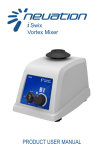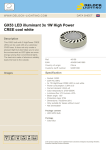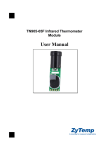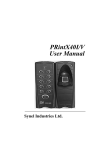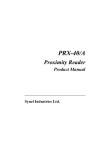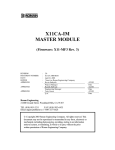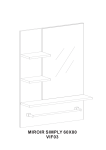Download AI7525 User manual 7.5.3.indd
Transcript
AI7525 Series Annunciators AI7525 Series Alarm Annunciator User Manual (Ver. 7.5.3 / April 2015) 3-350 John Street, Thornhill, Ontario L3T 5W6 Phone: 289 597 APEX (2739) Fax: 289 597 2200 Toll Free: 1 866 776 2943 Email: [email protected] Web: www.APEXANNUNCIATOR.com (1) AI7525 Series Annunciators Introduction The AI7525I Series Alarm Annunciator system is an unparallel, modular product, designed to give indication of an alarm condition, or equipment status, where a high degree of reliability and flexibility is required. The annunciator is made up of windows, each window being 75 x 50mm and comprising one large window, two medium (Vertically or horizontally) or four small windows. These alarm windows are driven from Two-channel Logic (Alarm) Cards. The annunciator is constructed by assembling multiple “windows” together to provide a unit of the shape and size required. The finished window array is housed within an attractive extruded aluminum surround which gives a modern flush mounting appearance and allows the annunciator to be mounted in a single cut-out. The AI7525I Series Alarm Annunciator is fully programmable for a whole range of different sequences and functions as listed in the ISA Publication “Annunciator Sequences and Specifications S18.1 - 1979”. The programming is undertaken by dipswitches and jumpers on each card. All Alarm Cards are generally interchangeable within the annunciator, so stocking requirements are minimized. As the system is fully field-programmable, the operating specification of both alarm sequence and function can be changed during commissioning or at a later date after the equipment is installed. Reliability of operation is increased over conventional annunciators by using state of the art technology on Alarm Cards. Each Card is fitted with a complete logic controller, which is capable of complete system control. Accessibility for normal maintenance, legend/filter changes and programming is excellent, being provided without the use of special tools. The standard unit is supplied fully equipped with a range of output relays as standard. This product will suit most applications. (2) AI7525 Series Annunciators Technical Specification If Technology Had This Button, AI7525 AI752 25 PAUSE Series Wouldn’t Exist Display GENERAL Configuration: Supply Voltage: - One single large window: (H11 type): 75x50mm (WxH) - Two medium window: (H21 type): 75x25mm (WxH) (H12 type): 37.5x50mm (WxH) (V21 type): 50x37.5mm (WxH) - Four small window: (H44 type): 37.5x25mm (WxH) 24VDC Nominal (20-28VDC) Supply Current Per Alarm Point: Quiescent: 4mA (at 24VDC) LEDs: H11: 80mA (at 24VDC) H21, H12, V21: 40mA (at 24VDC) H44: 20mA (at 24VDC) Relay: 10mA per relay (at 24VDC) Number of LED(s) per LED module: 2 Additional 50mA current is required for Number of LED module per Alarm Point: INPUTS Isolation and Polarity: - Each input is optically isolated up to 2000VAC - All inputs are bipolar and can accept AC or DC voltages Alarm Inputs: - Wet (voltage supplied) or dry (voltage free) contacts. Field Selectable for each channel individually - Normally Open (NO) or Normally Closed (NC). Field Selectable for each Alarm Controller (for example for H21 window type, two channels have the same setting) - Dry Contact and 24V (DC or AC) are standard inputs and other voltages are optional as below - Other input Voltages; 48,125, and 250V (DC or AC) Response Time: - Standard unit: 50ms milliseconds - Made to order from 1ms to 2s OUTPUTS Supported outputs: - Light Output - Critical Audible Relay - Non-critical Audible Relay - Critical/Non-critical Buzzer - Group Relay - Common Relay - Auxiliary (Repeat) Relay (can be set to follow Input or Output) - Common Alarm Relay - First-Up Relay - Relay Rating: - 1A@24VDC - 0.5A@ 120VAC H11: 4 LED modules H21, H12, V21: 2 LED modules H44: 1 LED module LED Module Color: - Yellow, Red, Green, White - Bi-color option is available with special order Interface Module, Pushbutton/Buzzer Module and Common Relay Environment: Operating temperature : -20 to 60ºC Storage temperature -20 to 80°C Humidity 0-95% RH, non condensing Protection: Front Panel: IP41 Enclosure: IP20 Legends: - Laser Engraved & color filled Weight: Approximately 0.3 kg per H11 window - Printed translucent film Connection Terminals: ALARM SEQUENCES System supports all ISA-S18.1/1979 (R1985) sequences including: - Manual Reset (M) - Automatic Reset (A) - Automatic Reset First Out (F3A) - Automatic Reset First Out (F1A) - Manual Reset First Out (F2M-1) - Ring back (R) - No Lock In These sequences are Field Selectable for each Alarm Controller (for example for H21 window type, two channels have the same sequence) PUSHBUTTONS “Acknowledge”, Reset”, “Test” and “Mute” pushbuttons are supported by the system with two choices; Remote and/or Integral pushbuttons (3) - Two-part removable screw type - Maximum wire size: 2.5 mm 2 Mounting: Panel mount (flush) AI7525 Series Annunciators AI7525 is an unparallel, modular Annunciator. It is manufactured from universal windows which can be assembled in an array to provide the number of rows and columns required to suit individual panel designs. Each window within the annunciator being 75 x 50mm (3``x 2``) is able to contain either one large, two medium or four small alarm windows. each window is illuminated by “plug-in” LED Modules providing a maintenance free solution, a reduction in power consumption and lower heat dissipation. The type of cards installed dependent on system specification and the required options. The following pages detail the system modules, individual window types, available options, system setting and wiring diagram. System Rear Overview, Modules and Connectors: Logic Card Logic Card(H44 type) Logic Card (If No PB module) Interface Module External Pushbuttons Alarm Inputs Common Relays Repeat Relay Outputs 24VDC (4) AI7525 Series Annunciators Window/Cell Configuration The AI7525 is modular and cell based designed. With the availability of multiple 75x50mm Windows and Cells sizes, customers will have access to a permutation of varying choices to build a system with desirable unit size. Available configurations are: - One single large window (H11 type): 75x50mm (WxH) - Two medium cells: (H21 type): 75x25mm (WxH) (H12 type): 37.5x50mm (WxH) (V21 type): 50x37.5mm (WxH) - Four small cells: (H44 type): 37.5x25mm (WxH) H12 H11 H12 V21 V21 H44 H44 H21 H44 H44 H21 75mm Calulation of overall and cutout sizes is very easy by using the following formulas: 37.5mm 40mm 50mm 20mm Overall Size Calculation of H11, H21, H12 and H44: _ 0.5 Width (mm)= C x 75 + 37 + _ 0.5 Height (mm)= R x 50 + 37+ Cutout Size Calculation of H11, H21, H12 and H44: _ 0.5 Width (mm)= C x 75 + 33 + _ 0.5 Height (mm)= R x 50 + 33 + 25mm 32.5mm Overall Size Calculation of V21: _ 0.5 Width (mm)= C x 50 + 37 + _ 0.5 Height (mm)= R x 75 + 37 + Cutout Size Calculation of V21: _ 0.5 Width (mm)= C x 50 + 33 + _ 0.5 Height (mm)= R x 75 + 33 + 65mm Visit the below link for Lens Replacement demonstration C: Number of 75x50mm Windows in one row R: Number of 75x50mm Windows in one column http://www.youtube.com/watch?v=Hfd0D7UofgM (5) AI7525 Series Annunciators Interface Module: Audible (Alarm Horn): Activates on alarm and remain active (within a group) until the Mute or Acknowledge pushbutton has been pressed (Horn 1 / Horn2). First-up: Activates when the first alarm occurs within a group Common Alarm (Group Alarms): Once channels have been assigned to groups (Critical, Non-critical), the user is able to link a group to a common relay APEX Automation Solutions AI7525 - INTerface Module Relays 1&2 Function Setting 2 4 6 8 Horn 2 1 3 5 7 2 4 6 8 First-up 1 3 5 7 2 4 6 8 Horn 1 1 3 5 7 2 4 6 8 24VDC Relay 2 Output Relay 1 Output External Pushbuttons Relays 1&2 Contact Setting Relay Output Contact Normally Open (NO) setting 1 2 3 1 2 3 1 3 5 7 2 4 Relay 2 6 8 Setting 1 3 5 7 2 4 Relay 1 6 8 Setting Relay 1 Out- 1 3 5 7 Relay 2 Out- Common Alarm Relay 1 Output Mute Relay 2 Output External Pushbuttons Test Dry Contact Relay Outputs Ack. + -- 24 VDC Reset Interface module communicates with Logic Cards and supports internal and external pushbuttons and provides common outputs such as internal buzzer and common outputs (First-up output, Common Alarm, Alarm Horn, etc.) There are two relays on Interface module. Function of relays can be set by jumpers as shown below allowing the relays to operate as: 1 2 3 Relay Output Contact Normally Close (NC) setting 1 2 3 AI7525-INT Interface Module For factory use only (6) AI7525 Series Annunciators Logic Card: Depend on window type (H11, H21, H44, H12, V21), each Logic card supports 1 or 2. Each logic card can be assigned to two different groups (Critical or Non-critical). Each Input can be configured individually to accept Dry (potential free) or Wet (powered) contacts. On standard system, user can select either Dry Contact or 24VDC signals. Another option is “Other Voltage”. Voltage of this option should be determined at the time of order. 2 4 6 8 ON 123456 1 3 5 7 2 4 6 8 1 3 5 APEX Automation Solutions 7 AI7525 - Logic card 4 6 8 2 4 6 8 1 3 5 7 1 3 5 7 1 Aux. Relay 1 2 3 Aux. Relay 2 -- Input 2 1 + Input 1 2 3 Relay 2 2 Relay 1 Optional 24 VDC Each Logic Card can be supplied with Auxiliary Relays (Repeat Relays) to provide the user with a dry contact (potential free contact) per alarm channel for use with 3rd party devices. These Repeat relays can be configured to operate in accordance with one of the following. - Input Follower: The relay changes state each time there is a change to the associated signal input contact - Output (display) Follower: The relay changes state on alarm and faithfully follows the display window (7) AI7525 Series Annunciators Logic Card Settings: The non alarm state of each individual channel can be configured to allow the channel to operate from either a NO or NC contact. Input Type Setting 2 4 6 8 Dry Contact Input 1 3 5 7 2 4 6 8 1 3 5 7 2 4 6 8 24V(AC/DC) Input Other Voltage Input 7 2 3 5 4 6 8 1 3 5 7 2 4 6 8 Output 1 Jumper 123456 ON Output 2 Jumper 1 1 3 5 7 APEX Automation Solutions AI7525 - Logic card Input 1 Jumper Input 2 Jumper 2 4 6 8 2 4 6 8 1 3 5 7 1 3 5 7 LED Setting Example 2 4 6 8 1 3 5 7 2 4 6 8 1 3 5 7 2 4 6 H11 LED Setting LED Jumper Setting Setting 8 1 3 5 7 2 4 6 8 1 3 5 7 H21 LED Setting PIN 1,2 3,4 5,6 7,8 (8) Close Output to LED M. 3 Output to LED M. 4 Output to LED M. 1 Output to LED M. 2 Open No Output to LED M. 3 No Output to LED M. 4 No Output to LED M. 1 No Output to LED M. 2 AI7525 Series Annunciators Logic Card Settings: 2 4 6 8 1 3 5 7 2 4 6 8 ON 123456 1 3 5 7 APEX Automation Solutions AI7525 - Logic card 2 4 6 8 2 4 6 8 1 3 5 7 1 3 5 7 1 2 3 4 5 6 Off On ON 1 2 3 Aux. Relay output follower NC Input(s) Critical Group Switch Sequence Manual Reset (M) Auto Reset (A) No Lock In (N) Ring Back (R) Auto Reset First Out (F1A) Manual Reset First Out (F2M-1) Auto Reset First Out (F3A) Switch 4 Switch 5 Off Off Off Off On On On Off Off On On Off Off On Off Aux. Relay Input follower NO Input(s) Non-critical Group Switch 6 Off On Off On Off On Off AIS7525 supports all ISA-S18.1/1979 (R1985) sequences. These sequences are Field Selectable for each Alarm Controller (Logic Card). For example for H11 type, each individual channel and for H21 type, each two channels will be set the same. Flowcharts of all sequences are available at the end of this document. (9) AI7525 Series Annunciators Auxiliary (Repeat) Relays - optional: Each Logic Card can be supplied with Auxiliary Relays (Repeat Relays) to provide the user with a dry contact (potential free contact) per alarm channel for use with 3rd party devices. These Repeat relays can be configured by DIP switch to operate in accordance with one of the following. Repeat relays function would be set per Alarm Controller (Logic Card). For example for H11 type, each individual channel and for H21 type, each two channels will be set the same. - Input Follower: The relay changes state each time there is a change to the associated signal input contact. - Output (display) Follower: The relay changes state on alarm and faithfully follows the display window. 2 4 6 8 4 6 8 2 4 6 8 1 3 5 7 1 3 5 7 7 APEX Automation Solutions AI7525 - Logic card 1 2 3 Relay 2 2 3 5 Relay 1 ON 1 1 2 3 123456 1 3 5 7 2 4 6 8 Aux. Relay 1 Aux. Relay 2 Repeat Relays Output Setting -- Input 2 + Input 1 24 VDC 1 2 3 Normally Open Output (NO) 1 2 3 Normally Close Output (NC) (10) AI7525 Series Annunciators Wiring Diagram: Power Supply Wiring +Fuse 24VDC power supply + F - +- An external FUSE is strongly recommended as shown above. Depend on system options, every 7-10 Logic Cards (usually each row) need one 24VDC power connection. One power connection for Interface module is mandatory. On standard systems, Interface Module is located in the bottom left hand corner of unit when viewed from the rear. +- Typical wiring diagram of system power supply (11) AI7525 Series Annunciators Wiring Diagram: Alarm IIuputt Wiring Al Wi i Depend on window type (H11, H21, H12, V21, H44), each Logic card supports 1 or 2 inputs. Each Input should be configured individually to accept Dry Contact (potential free) or powered contacts. Make sure all inputs have been configured properly before wiring the system, otherwise system will be damaged. Please ensure there is no external links between Input terminals and power supply terminals and wires. All “2” Input terminals are internally connected. Using this terminal for common wire for inputs is permitted ONLY by considering the below note. 1 21 2 Input 2 1 21 2 Input 1 Powered Common Inputs Input 1 Input 2 Input 1 1 21 2 Powered Individual Inputs Input 2 Dry Contact (potential free) Inputs 0 0 + 0 + power supply power supply power supply F + Fuse Alarm Signals Alarm Signals Alarm Signals Recommended wirings Note: To use the same 24VDC power source which is supplying the system, ensure that there is no external links between Input terminals and power supply terminals and wires. Typical diagrams of Inputs Wiring (12) AI7525 Series Annunciators Wiring Diagram: Common Output Relays Wiring There are two relays on Interface module. Function of theses relays can be set allowing the relay to operate as: Output 1 - Audible (Alarm Horn): Activates on alarm and remains active (within a group) until the Mute or Acknowledge pushbutton has been pressed (Horn 1 / Horn2) Output 2 1 21 2 Dry Contact (potential free) Outputs - First-up: Activates when the first alarm occurs - Group Alarm (Common Alarm): Once Logic Cards have been assigned to groups (Critical, Non-critical), the user is able to link a group to a common relay. Output 1 HORN Output 2 1 21 2 Each relay is equipped with a change-over contact and the user can select the contact state to NO or NC. HORN power supply External horn or buzzer wiring Typical wiring diagram of Alarm Outputs (13) AI7525 Series Annunciators Wiring Diagram: External (remote) Pushbuttons Wiring 1 23 4 - Mute Test Acknowledge Reset F Fuse +24VDC (from same power source supplying the system) :Momentary Normally Open Pushbutton External (remote) pushbutton wiring diagram (14) +- + power supply As an alternative, Pushbutton Module can be supplied as a remote item or the user can use conventional panel mounting momentary, normally open, pushbuttons to control the Annunciator. AI7525 Series Annunciators Wiring Diagram: Repeat Relays Wiring Individual channel Repeat Relays (Auxiliary Relays) Each 2 channel Logic Card can be supplied with optional Repeat Relays to provide dry contact (potential free) contacts per alarm channel to be used with 3rd party devices. Each relay is equipped with a change-over contact and the user can select the contact state to NO or NC. These relays can be configured to follow either input (Input Follower) or output (Output Follower). This configuration would be set per Alarm Controller (Logic Card). For example for H11 type, each individual channel and for H21 type, each two channels will be set the same. Output 1 output 2 output 1 power supply power supply Output 1 1 21 2 1 21 2 Dry Contact (potential free) Outputs Powered Outputs Typical diagram of Repeat Relays Wiring (15) (15) AI7525 Series Annunciators Window Lens Replacement: Both Engraving and translucent film film ccan be used for alarm labeling (alarm legends). Lens (or film) replacement doesn’t need any special tools. Each window has surrounded with a plastic bezel. There is a small slot at the bottom of each window (behind plastic bezel) which allows a flat terminal screwdriver to be used to gently lever the lens forward. To replace a window lens (or film) follow the following simple steps. 1- Insert the screwdriver inside the slot between the windows and pop it up gently 2- Remove the plastic bezel 3- There is a small slot at the bottom of window 4- Insert the screwdriver inside the slot and lever the lens forward Visit below link for Lens Replacement demonstration http://www.youtube.com/watch?v=Hfd0D7UofgM (16) 5- Remove the lens AI7525 Series Annunciators 6- Place the new lens inside the frame 7- Put the screwdriver inside the slot and push the lens in 8- Secure the lens 9- Put the plastic bezel back in place 10- Push the corners of plastic bezel (17) AI7525 Series Annunciators Plug-in LED Module Replacement: T reduce To d the th power consumption ti an to t provide id a maintenance free solution, Each window is illuminated by almost unlimited life time “plug-in” LED Modules. Each LED module comes with two high bright, 120°, long life LEDs. Number of LED modules depends on window type. Generally, each H11 (large window) has 4 LED modules so, each H21 has 2 and each H44 has 1 LED module. No special tools needed to replace the LED modules. To remove and install LED modules, just a general purpose pointed plier is needed. Below picture show how to remove and install the LED modules. Make sure all 8 pins of LED Module connector have been inserted properly when installing the LED Module, otherwise system could be damaged. (18) AI7525 Series Annunciators Alarm Sequences: Manual Reset (Sequence Code M) Auto Reset (Sequence Code A) P: Normal S: Normal V: Off A: Silent No Lock In P: Normal S: Normal V: Off A: Silent To Abnormal Acknowledge owledge while Normal P: Abnormal or Normal S: Alarm V: Flashing A: Audible P: Normal S: Normal V: Off A: Silent To Abnormal P: Abnormal or Normal S: Alarm V: Flashing A: Audible P: Abnormal or Normal S: Alarm V: Flashing A: Audible Acknowledge while Abnormal Acknowledge A k l d P: Abnormal or Normal S: Acknowledged Reset while V: On Normal A: Silent Return to Normal P: Abnormal or Normal S: Acknowledged Return V: On to Normal A: Silent Auto Reset First Out (Sequence F3A) P: Normal S: Normal V: Off A: Silent P: Normal S: Normal V: Off A: Silent Subsequent to Abnormal Subseque Subsequent to Abnormal First to Abnormal Acknowledge while Normal P: Abnormal or Normal S: Subsequent Alarm V: On A: Audible Return to Normal Acknowledge P: Abnormal or Normal S: First Alarm V: Flashing A: Audible Acknowledge (First-out Reset) Acknowledge while Abnormal P: Abnormal S: Subsequent Acknowledged V: On A: Silent Acknowledge First-out Reset while Abnormal Return to Normal P: Abnormal or Normal S: First Acknowledged V: Flashing A: Silent Legends: S: Sequence V: Visual A: Audible First out Reset P: Abnormal or Normal S: First Alarm V: Intermittent Fast Flashing A: Audible Mute P: Abnormal or Normal S: First Silenced V: Flashing Acknowledge (First-out Reset) A: Silent P: Process First to Abnormal P: Abnormal or Normal S: Subsequent Alarm V: Fast Flashing A: Audible Mute P: Abnormal or Normal S: Acknowledged V: On A: Silent Acknowledge while Abnormal P: Abnormal S: Acknowledged V: On A: Silent Manual Reset First Out (Sequence F2M-1) Reset while Normal To Abnormal Return to Normal AA: Alarm Audible (19) RA: Ringback Audible AI7525 Series Annunciators Alarm Sequences: Auto Reset First Out (Sequence Code F1A) With No Subsequent Alarm State Ring Back (Sequence Code R) Reset P: Normal S: Normal V: Off AA: Silent RA: Silent Legends: P: Process Return to Normal Acknowledge while Normal P: Normal S: Ringback V: Slow Flashingreturn AA: Silent to normal RA: Audible Return to Normal To Abnormal A Return to Abnormal P: Abnormal or Normal S: Alarm V: Fast Flashing AA: Audible RA: Silent S: Sequence Subsequent to Abnormal P: Abnormal or Normal S: Acknowledged V: On A: Silent P: Abnormal S: Acknowledged V: On AA: Silent RA: Silent First to Abnormal P: Normal S: Normal V: Off A: Silent Acknowledge while Normal (First-out Reset) Acknowledge A w while Abnormal (First-out Reset) (F P: Abnormal or Normal S: Alarm V: Flashing A: Audible Acknowledge while Abnormal V: Visual A: Audible AA: Alarm Audible RA: Ringback Audible Visit the below links for Manual Reset & Auto Reset demonstration. http://www.youtube.com/watch?v=XgYib4a5PoE http://www.youtube.com/watch?v=j7n6RerSviQ Integral Pushbutton & Buzzer Module (option) Standard AI7525 Series Annunciators supports four remote Pushbuttons (Acknowledge, Reset, Test, Mute) and two Horns. As an option, an integral “Pushbutton & Buzzer Module” can be fitted in the bottom right window. Order Number Model # AI7525 Number of Windows in a Column (wide) 03 04 Number of Windows in a Row (high) Signal Voltage V0: Dry Contact V1: 24VDC/AC V2: 48VDC/AC V3: 125VDC/AC V4: 250VDC/AC V5: Others (Specify) H21 V1 Pushbutton & Buzzer Module 1: With 0: Without 1 Auxiliary Relay 1: With 0: Without Window Configuration (20) 1 Auxiliary Relay 1: Follow Input 0: Follow Output 1 N




















